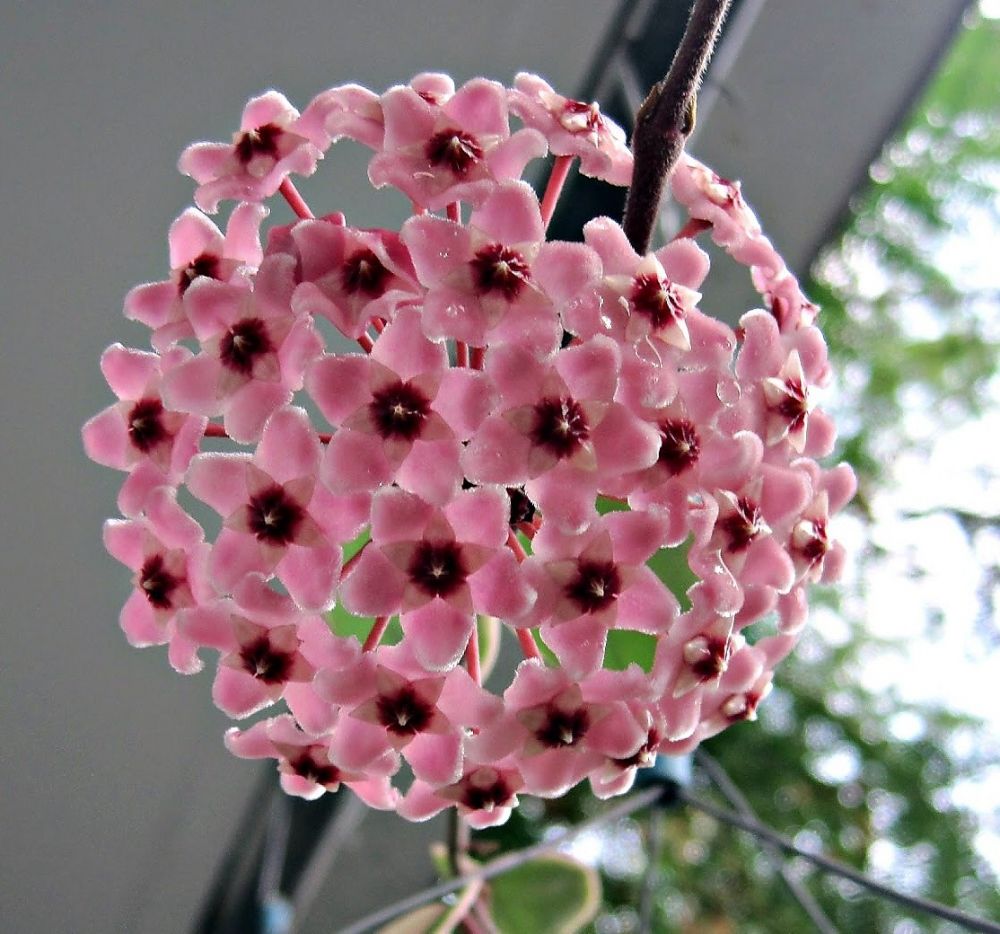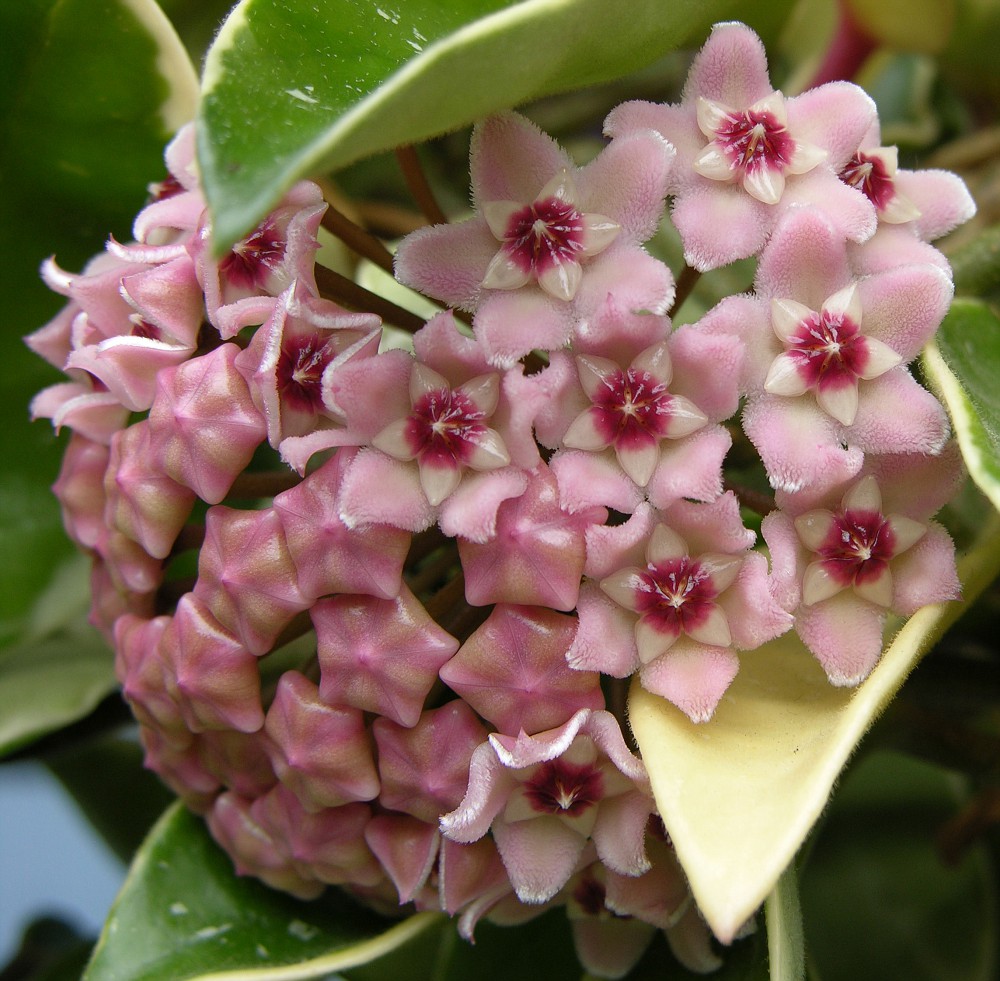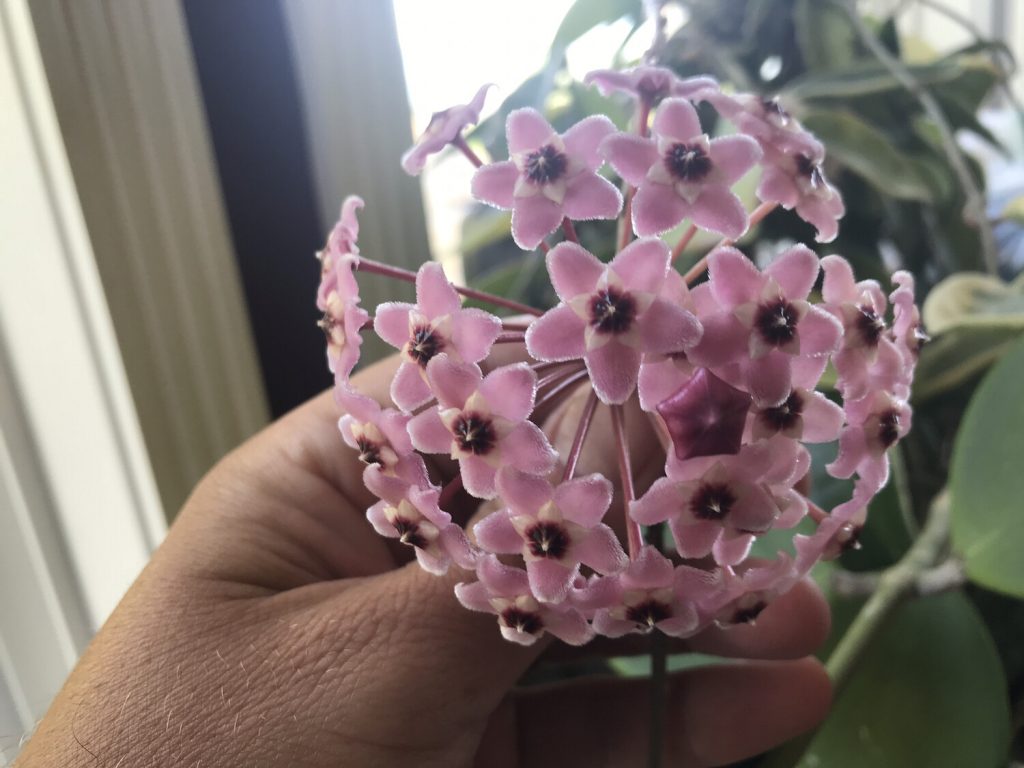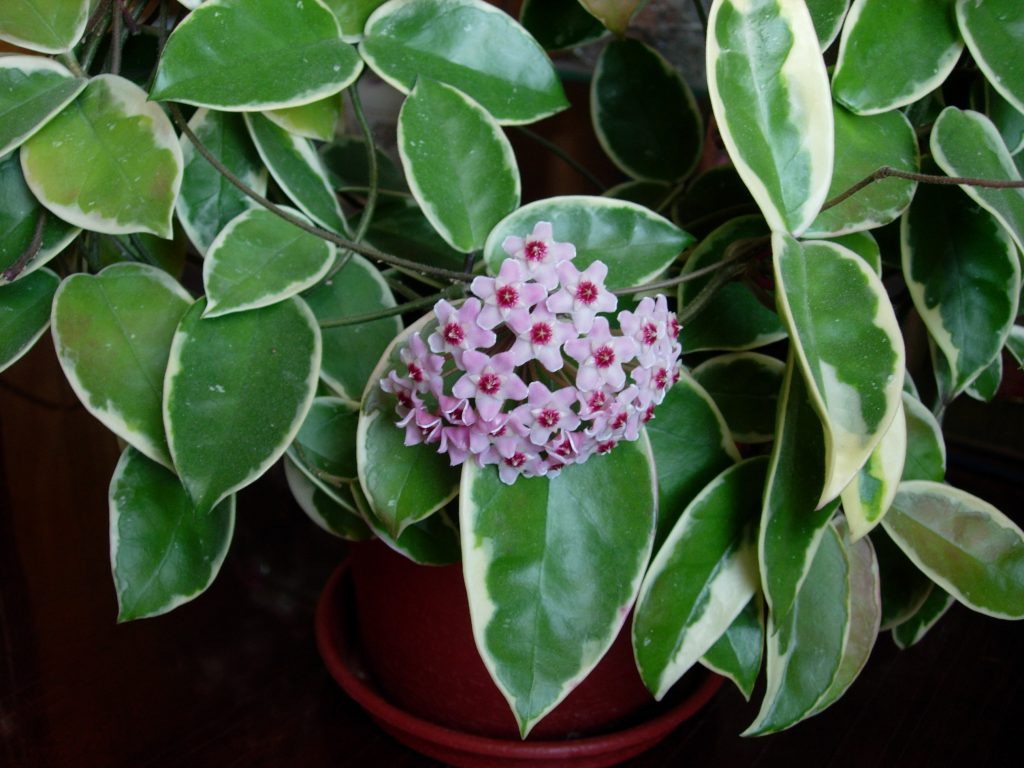Hoya Crimson Queen - description of the plant
The decorative liana - Hoya Crimson Queen - is in great demand in home floriculture for its harmlessness, pleasant aroma, attractive appearance and the ability to easily tolerate the neighborhood of other vegetation. The homeland of growth is India and Australia. Consider what the variety looks like and what growth conditions it needs at home.

Hoya carnosa krimson queen
general characteristics
A plant of the Kutrovye family, the botanical name is hoya Krimson Queen. You can identify this variety by the following description:
- characterized by intensive growth - the annual growth of shoots is 40 cm;
- stems are thin, cylindrical, erect at first, later becoming creeping or drooping;
- small leaves - 7 cm long, 2-3 cm wide, with a glossy surface and a waxy coating;
- multi-colored sheet plate - the main color is emerald with elements of pink, white or beige in the form of stripes, edging or strokes;
- buds are small (diameter 1-1.5 cm), light pink with a burgundy crown, collected in inflorescences-umbrellas of 20-25 pcs.
During the flowering period, which lasts from June to October, the hoya thinns the pleasant sweetish aroma, the flowers emit transparent nectar.
Purchase and adaptation
You can buy the Crimson Queen variety in one of the flower shops. When buying, carefully inspect the stems, leaves, inflorescences - they must be fresh, without signs of disease, pests, and also without mechanical injury.

Hoya crimson queen care and reproduction
Healthy seedlings have leaves and shoots of a rich tone, in accordance with the characteristics of the variety. The substrate is moist, does not contain acidification and mold on the surface.
Shake off the crown lightly, if the foliage does not crumble, then the hoya is healthy and you can safely buy it.
After acquisition, the plant is kept in a separate room for 20 days in order to understand whether it is sick with something or not. During this period, the hoya will have time to adapt to indoor growth conditions.
Landing rules
For planting, light, well-drained soil with a neutral acidity level is suitable. Sod, leafy soil, humus and sand are mixed in a ratio of 2: 2: 1: 1. Many growers use already purchased substrate for growing decorative flowering plants.
He loves a lot of light, therefore, they are placed on windows from the south or south-west side. At lunchtime, shade is created to eliminate the risk of burning leaves and inflorescences.
When kept on the eastern and northern windowsills, artificial lighting with a fluorescent lamp will be required.
The necessary conditions
The successful cultivation of ornamental liana depends on the observance of certain conditions.

Hoya crimson queen care
Temperature
The optimal regime in the warm season is 22-27 ° С. In summer, it can be taken out onto a balcony, loggia or terrace, where there is no wind, direct rays and precipitation.
In winter, they are kept cool at a temperature of 15-16 ° C. Does not tolerate drafts, but loves fresh air.Therefore, the room is regularly ventilated, during this time the plant is taken out to another room.
Humidity
Prefers high humidity - 75-80%. Therefore, in spring and summer, the crown is irrigated every other day. In cold seasons, this procedure is carried out once a month to wash away dust and prevent the appearance of spider mites.
Spray with warm, settled water in the morning or evening hours.
Lighting
This plant has a long light day - it needs at least 12 hours per day. During the growing season, this condition provides sunlight. In autumn and winter, they are supplemented with a fluorescent lamp - set at a distance of 50 cm from the crown.
Care requirements
An exotic liana is not demanding to care for - it needs periodic moistening, loosening, feeding and sanitary pruning.

Hoya crimson queen
Watering
Does not tolerate excess moisture - the root system begins to rot. Therefore, watering should be abundant, but not frequent - only after the soil has dried to a depth of 3-4 cm.
During the growing season, the frequency is once a week, in the cold season - every 14 days. Moderate moisture in winter contributes to high-quality and long-lasting flowering.
Top dressing
Store-bought mineral formulations with a high potassium content are used. They feed for the first time at the beginning of March, the last time at the end of August.
The frequency of fertilization is once every two weeks. In order for the roots to quickly absorb nutrients, after feeding, abundant watering is carried out.
Pruning
Adult flowers do not need shaping, pinch young specimens at the stage of the appearance of the fourth leaf. This stimulates the formation of lateral processes. You can also do light pruning to improve bushiness and flowering quality. The stems are cut to 12-15 cm in length.
Together with these manipulations, they carry out a sanitary haircut - they cut out all the leaves and shoots that have turned yellow, dried out or began to rot. Places of cuts are sprinkled with charcoal, and after drying, the crown is irrigated with Epin, which helps the flower to recover faster.
Transfer
Three weeks after the purchase, the purchased hoya is transplanted. Take a flowerpot 2-3 cm in diameter larger than the previous one with drainage holes at the bottom. Expanded clay is poured, then the fertile composition used when planting flowers. They moisten the plant, remove it and, together with a clod of earth, transfer it into a new container. The soil is poured to the top, tamped, watered.
Young specimens should be transplanted after a year, adults - every fourth year.
You need to transplant a flower whose roots have rotted, otherwise it will quickly wither and die. It is moistened, taken out of the pot, and dipped in a basin of water to wash off the remnants of the soil. All rot is cut off, dipped in a fungicide solution, dried. Places of cuts are sprinkled with charcoal, then planted in a new flowerpot with a sterile mixture.
Reproduction methods
If you wish, you can propagate hoya at home in several ways. Subject to all the rules, the cultivation of new seedlings will be successful.

Hoya crimson queen photo
Cuttings
Harvesting of planting material is carried out during trimming. Cut off the tops of the stems with several leaves and buds. The length of shoots for planting should be at least 15 cm.
At the bottom, foliage is cut off, then dipped in Epin's solution for half an hour to stimulate rapid rooting.
Cuttings are planted in a damp mixture of peat and sand to a depth of 3-4 cm. In order for them to take root, they are placed in a warm place with a temperature of 22-25 ° C and diffused light. Moisten if necessary.
After 15-20 days, they will begin to release new leaves - a sure sign of successful rooting. After 4 weeks of growing, the seedlings are planted in separate pots.
Sheet
Adult leaves with axillary buds are selected, cut off from the stem with a sharp instrument, dipped in Kornevin's solution. They are planted in a peat-sand mixture, watered with warm water. For rooting, they need to be covered with transparent film or glass. The roots will appear in 2 weeks.During this time, the planting is regularly moistened, aired every day.
As soon as the leaves grow, the shelter is removed, they continue to look after for another 1-2 years, until the stems grow. Then they are transplanted into separate flowerpots.
Seeds
This process is lengthy and requires a lot of patience. For planting, you will need purchased seeds with the current expiration date. They are sown in a mixture of peat and sand with the addition of crushed sphagnum moss. The seeds laid out on the surface of the substrate are covered with a thin layer of loose soil. Moisten from a spray bottle, cover with a film.
Germination will take 7-12 days. After the appearance of greenery, the shelter is removed, a temperature regime is provided within the range of 22-25 ° C and diffused lighting. They grow for another three months, until they release one pair of leaves, then dive into individual pots.
Diseases and pests
The defeat of infections or parasites occurs extremely rarely, only if the conditions of detention and care are violated.
| Diseases and pests | Signs | Treatment | Prophylaxis |
| Root rot | Due to frequent overflows of cold water, the root system begins to rot, then the stems. They take on a brown or black tone, soften, become watery | Remove from the pot, if the roots are all rotted away, the hoya is disposed of, several cuttings are cut for rooting. With a slight lesion, cut out all the rot, treat it with a fungicide, dry it, and plant it in a new container with disinfected soil | Adjust watering, use warm water (40 ° C) |
| Spider mite, scale insect, aphid, mealybug | The leaves turn yellow or become covered with brown, black spots, curl, dry out and crumble | Cutting of diseased organs. Insecticide treatment - Aktellik, Fitoverm, Aktara or Decis | Purchase of healthy plants, quarantine aging. Timely pruning of non-viable stems and leaves. Compliance with temperature and humidity levels |

